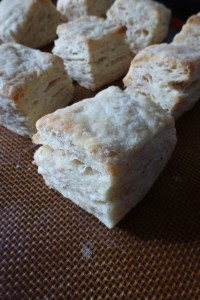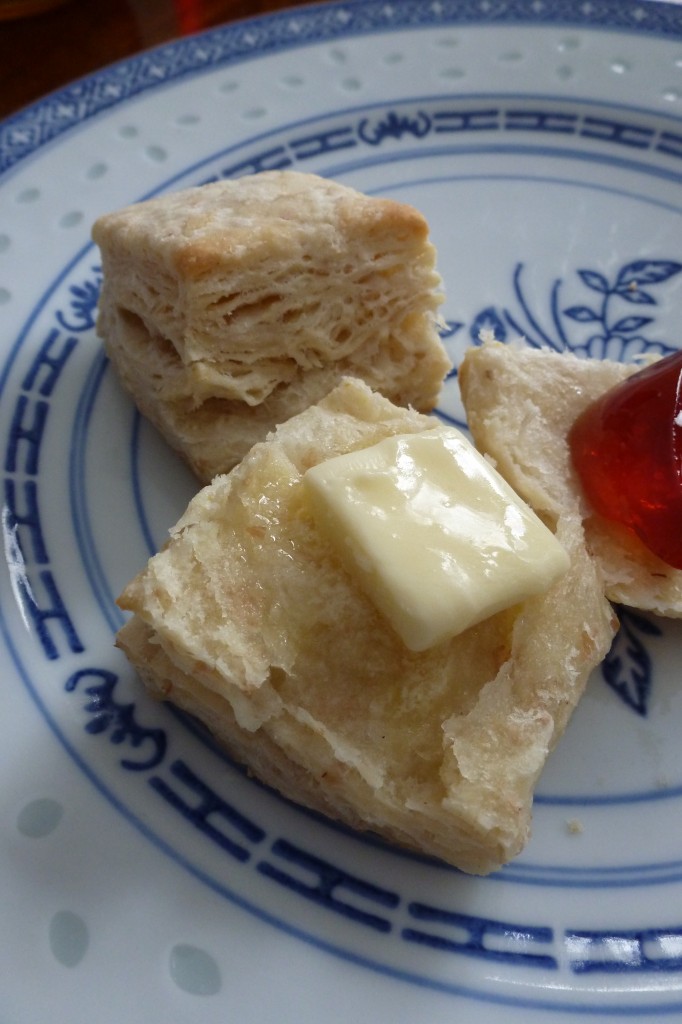 When I was little we called these savoury pastries “scones,” our pronunciation rhyming with the word “owns”, but they are much more like American biscuits than British scones (the pronunciation of which rhymes with “lawns”).
When I was little we called these savoury pastries “scones,” our pronunciation rhyming with the word “owns”, but they are much more like American biscuits than British scones (the pronunciation of which rhymes with “lawns”).
For the sake of clarity I’ve taken to calling them biscuits. Whatever you call them, they are flaky quick breads made with butter, milk, and flour. A little salt and a little baking powder. That’s it.
My mom used to make a ham and cheese biscuit. She made her dough with milk soured with vinegar (buttermilk would have been used when she was growing up, but we never had this in our fridge). The dough was rolled into a sheet, covered with slices of ham and grated cheddar cheese, then rolled into a log. This was baked, then sliced into rounds to reveal the spiral cross-section. Make a salad, and that was dinner.
Anyways.
The Dough. My preferred method is to sift together flour, baking powder, and salt, then grate very cold butter into those dry ingredients and mix to combine. Make a well in the centre, add buttermilk, and stir together until a dough forms.
To get a very flaky biscuit you can use a rolling method similar to that used for puff pastry. Roll the dough into a rectangular sheet, then fold one third of the rectangle into the centre, then the opposite third towards the centre. By re-rolling and repeating this procedure you create several distinct layers within the biscuit. If you roll and fold more than twice, you should let the dough rest thoroughly before continuing. This makes the entire biscuit-making process a lot longer, but it gives the biscuits a very distinctive, rustic layering. Once baked they’ll pull apart effortlessly for easy butter application.
On Shaping. Biscuit dough is traditionally rolled out and punched into rounds with a ring mold. This leaves behind a lot of trim, which has to be reformed and punched again. The biscuits from the second shaping never rise as high or as evenly as the first rounders. My question is, why do we cut biscuits into rounds? Why not roll out the dough, then cut it in a grid pattern to make square biscuits, lessen trim and get a more consistent batch? Something to consider.
On Baking and the Even Rise. Chefs use several techniques to ensure that biscuits rise evenly in the oven and don’t slump to one side or the other. I don’t know how effective they are, but I do them all, just in case. I suppose I’m superstitious.
The most common tip is to roll out the dough in all directions. Don’t just roll the dough away from you; roll it away from you, towards you, to each side, and on the diagonals. This way the gluten is evenly stretched and will not favour a certain direction when the dough rises.
My pastry instructor at culinary school insisted that the biscuits be lined up close together on the baking sheet. Close, but not too close. Maybe an inch apart. I don’t have a clear idea of how this helps. Maybe the biscuits don’t want to touch each other, so they’ll rise straight up to avoid leaning over and brushing against their neighbour. Again, I don’t know why it helps, but I’ve never tried not doing it for fear of what might happen.
Usually it’s nice to have pastries with a deep golden-brown surface, but if brought to this point biscuits will be too crusty. They should be very lightly browned, and have a delicate, crisp exterior.
With the theory out of the way, here is a formal recipe.
Biscuits
Master Ratio – 3:1:2 flour, butter, buttermilk
Ingredients
- 12 oz all-purpose flour
- 1/2 tbsp kosher salt
- 1 tbsp baking powder
- 4 oz unsalted butter, very cold
- 8 oz full fat buttermilk
Procedure
- Sift together the flour, salt, and baking powder into a large bowl. Using the large holes of a box grater, grate the cold butter into the flour and mix so that it is evenly distributed.
- Make a well in the centre of the flour mixture. Add the buttermilk. Stir so that flour is slowly incorporated into the buttermilk. Continue until the dough forms. Knead very briefly until the dough is somewhat smooth. Wrap the dough tightly in plastic and refrigerate for at least 15 minutes.
- Roll the dough out into a rectangle about 1″ thick. Fold in thirds as described above. Repeat the roll and fold, then wrap the dough tightly in plastic and refrigerate about 1 hour.
- Repeat step three two more times.
- Roll the dough to 1″ thickness, then cut to desired shapes. Line the biscuits on a bake sheet so that they are about 1″ apart. Bake in a 375°F oven until cooked through and lightly browned.
